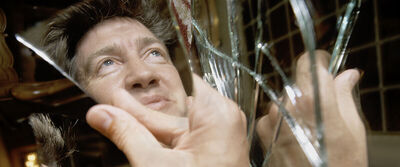
Over two decades ago, when I had a big job at a big glossy magazine, my boss, the guy who hired me, got fired, and a new editor-in-chief was installed. I was sad and also mildly terrified. Largely because I was just like that whenever I was in a straight job situation—convinced that without my corporate sponsor, so to speak, I’d be found out as a fraud and kicked to the curb.
I needn’t have worried, as I outlasted this new boss by almost another decade. He was a younger man, quite amiable and more actively plugged into certain parts of the zeitgeist than I. But I was very eager to please. One evening early in his tenure, he invited a group of senior staff out for drinks at the Plaza Hotel’s iconic Oak Bar. After we’d been sufficiently steeped in Scotch, he said to me, “You know, you strike me as the kind of guy who will watch the first 20 minutes of 'The Wizard of Oz' while listening to side one of Dark Side of the Moon.”
For you youngsters out there, this was a kind of meme at the time—some stoned so-and-so had discovered that in ways that were actually quantifiable (especially if you were, in fact, stoned), the imagery of “Oz” and the sounds of Pink Floyd synched up in an uncanny way. Like, you know, the twister coincided with some gnarly squiggly VCS synthesizer noodling. The thing was, at the time, and at all times since it had never even occurred to me to try this myself. I wasn’t THAT into Floyd, and I’d been around sufficiently to understand that ANYTHING can synch up if your individual will demands it. Still, I was, as I believe you can infer, eager to please, and I nodded my head avidly, and late that night, when I got home I tried the exercise, just so I wouldn’t be a liar, and was, to be honest, mildly impressed.
Why did the synch work? Various reasons, none of them that Pink Floyd had planned.
“The Wizard of Oz” is a work both archetypal and unique, and as the critic Amy Nicholson notes in the first chapter of this multi-essay documentary directed by Alexandre O. Philippe, its place in the firmament of world culture is almost an accident of fate. On its theatrical release in 1939, the movie flopped and was considered an expensive boondoggle. As with “It’s a Wonderful Life,” the film's second life on television made “Oz” ubiquitous and beloved. In his chapter, “Kindred,” the filmmaker and writer John Waters recollects first seeing “Oz” on television in his hometown in Baltimore, Maryland, and reckons that Lynch had had to have first seen it that way as well, either in Boise, Idaho, or Missoula, Montana, two of the very not-very-different-from-Kansas ultra-American locations where Lynch grew up. (And became, among other things, an Eagle Scout.)
A visual artist by training, Lynch has never identified as a cinephile in the way giants like Scorsese and Spielberg have. In interviews, he’s been known to shrug off vast swaths of film history that journalists try to pin on him, looking for answers to the multitudes of enigmas in his own films. But "The Wizard of Oz" is one influence he will definitely cop to. In one of the best of the six chapters here, filmmaker Karyn Kusama recalls attending a screening of Lynch’s 2001 "Mulholland Drive" at New York’s IFC Center, where Lynch sat for a Q&A afterward. There, he said, “There’s not a day that goes by that I don’t think about ‘The Wizard of Oz.’” And the references are strewn throughout Lynch’s films like stray seeds, from place and proper names (“Garland” is both a street name and the name of a character in “Twin Peaks”) to lots of outright wearing and heel-clicking of red shoes.
The contributors here are Nicholson, Kusama, Waters, filmmakers Rodney Ascher (“Room 237” and “A Glitch in the Matrix”), Aaron Moorhead and Justin Benson ("The Endless"), and David Lowery (“Pete’s Dragon”). Lowery is the one who most insistently connects Lynch’s work to his own by way of both “Oz” and “Peter Pan.” Philippe gives each of these narrators their own heads, so to speak, but still takes writing credit on the movie. I suspect he provided a lot of fodder for each chapter-speaker to work with, like the information that the obscure 1941 proto film noir “I Wake Up Screaming” uses “Over The Rainbow,” by this time hardly a standard (“Oz” had flopped, remember), as a musical leitmotif throughout.
The way Philippe organizes the hundreds of clips provides more startling and exhilarating moments per minute than most movies about movies can muster, although I can’t say that aficionados of ostensibly realistic cinema aren't going to be too thrilled. Which is too bad, because among the many things this picture illuminates is how the fanciful worlds of “Oz” and Lynch illuminate the pain and splendor of the world we have to inhabit once we leave the magic realm of cinema.
Now playing in theaters.
0 Commentaires